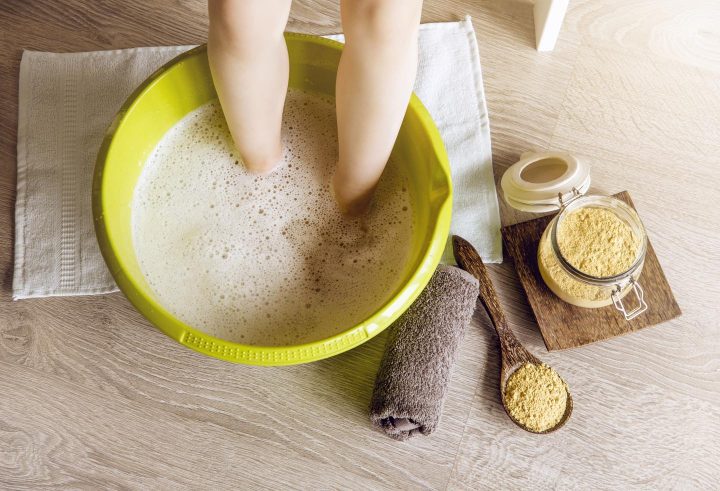This simple and effective hydrotherapy procedure boosts the immune system, helps to lower high blood pressure, improves sleep, and relieves pain from congestive headaches! Discover how it works.

What is the Hot Foot Bath?
The hot foot bath consists of placing the feet in hot water (starting at 100 to 104⁰F / 38 to 40⁰C) and applying a cold compress to the head for 15-20 minutes. It is given at temperatures ranging from 100 to 115⁰F (38 to 46⁰C). This treatment can be given with the patient sitting in a chair or lying down. Either way, you need to protect the mattress or floor with a plastic sheet.
Health Benefits:
This treatment helps to balance circulation and decrease congestion in the head, lungs, pelvic organs, and internal organs. The treatment acts as a derivative. A derivative effect happens when heat is applied to a large area of skin and its effect is to draw blood away from a distant internal organ. A hot foot bath draws congested blood away from the brain, lungs, and pelvis. If prolonged, it can elevate the body’s temperature which will increase the mobility of white blood cells. For that purpose, you would want to cover and tuck in a blanket around the patient so that body heat will not be lost.
Indications for a Hot Foot Bath:
Generally, a hot foot bath helps to relieve congestive headaches, chest congestion, pelvic congestion, stop a nosebleed, aid relaxation and comfort, abort or shorten a common cold, influenza, and painful menstruation.1)Dail. C. and Thomas, C. Hydrotherapy: Simple Treatments for Common Ailments, Teaching Services, 1989. The hot foot bath is useful for osteoarthritis in the feet if there is no pronounced swelling. We have found at our Lifestyle Center that the hot foot bath, when combined with a fomentation to the kidneys, reduces elevated blood pressure. Not only does a hot foot bath balance the circulation, it also increases parasympathetic nerve activity.2)Saeki Y. The effect of foot-bath with or without the essential oil of lavender on the autonomic nervous system: a randomized trial. Complement Ther Med. 2000 Mar;8(1):2-7. https://pubmed.ncbi.nlm.nih.gov/10812753/
Benefits of a Warm Footbath:
Coronary Artery Disease and Hypertension
A warm footbath has a temperature range between 92 to 100⁰F (33 to 38⁰C). A warm footbath can improve blood flow in the coronary arteries in individuals with mild to moderate coronary artery disease.3)Yoon SJ. Echocardiography. 2011 Nov; 28(10):1119-24. A warm footbath with red ginger has been found to reduce both elevated systolic and diastolic pressures in elderly hypertensive individuals.4)Fithriyani, Putri,et.al. Effect of Hydrotherapy Warm Red Ginger to Reduce Blood Pressure on Elderly at Panti Werdha Budi Luhur, Jambi. Indian Journal of Public Health Research & Development. Mar 2020, Vol. 11 Issue 3, p1968-1972. 5p
Warm Footbath & Diabetes
In a randomized clinical trial of 60 diabetic individuals, a warm footbath that contained 5 liters of warm, tolerable water with 250 grams of dissolved mineral salts reduced pain from diabetic neuropathy.5)Vakilinia SR, et al. Evaluation of the efficacy of warm salt water foot-bath on patients with painful diabetic peripheral neuropathy: A randomized clinical trial. Complement Ther Med. 2020 Mar; 49:102325. https://pubmed.ncbi.nlm.nih.gov/32147053/
Improved Sleep and Traumatic Brain Injury
Hot or warm footbaths are useful in cases of insomnia. Several studies suggests that when the feet are warmed before retiring to bed, a person falls asleep faster and the sleep is deeper.6)Sinclair, Marybetts, Hydrotherapy for Massage Therapist, Lippincott, Williams, and Wilkins, 2008, p. 130-132. This could be very helpful for the anemic patient who has insomnia. A warm footbath can also improve the sleep of those who have the chronic phase traumatic brain injury.7)Chiu HY. A Feasibility Randomized Controlled Crossover Trial of Home-Based Warm Footbath to Improve Sleep in the Chronic Phase of Traumatic Brain Injury. JNeurosci Nurs. (2017) https://pubmed.ncbi.nlm.nih.gov/29117035/

Contraindications for a Hot Foot Bath:
- Circulatory disturbances, peripheral arterial disease
- Impaired sensation (neuropathy)
- Blood vessel disorders
- Swelling in feet and legs
- Varicose veins
- Skin rashes on legs
- Rheumatoid or gouty arthritis in the feet when the joints are “hot” and swollen
- Diabetes
Note: Warm foot baths can be tolerated by most diabetic individuals. If there are good foot pulses present, diabetic individuals can usually tolerate a 102°F (39⁰ C) foot bath.
Equipment Needed:
- Chair
- Water bath thermometer
- Plastic “sheet” (or try a clean large trash bag)
- Foot tub with hot water in it. A five gallon galvanized bucket is ideal.
- Bath towel
- Blanket
- Pitcher with hot water
- Small pitcher
- Basin of ice water and two washcloths
- A hand towel
Extra Tips:
- It is so much easier to give this treatment in the kitchen or bathroom where running water is available.
- Be sure the room is warm and draft free. If the room is cool, the effectiveness of a hot foot bath is compromised.
- Adding epsom salts to the hot water could help relieve sore feet even more.
- Adding two teaspoons of mustard powder or 1 teaspoon of powdered ginger per two gallons (8 liter) of water will increase the vasodilation effect of the hot foot bath.
- A short cold footbath (five minutes) can reduce uterine bleeding.
- Giving a hot herbal tea before the treatment will help raise the temperature. This would be important if the hot foot bath is given to stimulate the immune system.

Procedure for Hot Foot Bath:
- Cover the bed mattress with plastic sheet under the bottom sheet to protect the bed.
- Have patient undress and lie down on the bed, covering patient with sheet and blanket. Please keep patient modest at all times. Depending on the condition of the patient, you can have him sitting in a chair.
- Fill foot tub ¼ full of water at 103-104⁰F (39 to 40⁰C). For individuals without diabetes, neuropathy, peripheral vascular disease, the water temperature is gradually increased. You may fill the tub before patient comes for treatment or while patient is getting undressed.
- Place patient’s feet in tub. See that edge of tub does not touch the calves of the patient’s legs. Be sure to drape a sheet over the legs in the tub to keep out drafts. Don’t let the sheet dip into the water.
- Apply cold compress to patient’s head once the person begins to sweat or gets hot. Renew compress approximately every 2-3 minutes.
- Have patient put one foot upon the other, moving the feet to one side of the tub of water. Pour in hot water carefully while mixing with your hand, making it hotter to patient’s tolerance or per doctor’s orders. Add hot water gradually until the temperature is 110 to 115⁰F (43 to 46⁰C). Always keep one of patient’s feet in the tub so they may tell you when water is hot enough. You might need to remove some of the “old water” with a small pitcher before adding more water.
- Finish the treatment by pouring cold water over feet and dry feet thoroughly. Or, you may dry the feet without the cold water pour if you immediately place socks on the dried feet. If sweating has occurred, patient should dry off completely.
- Have the patient rest in bed for 20-30 minutes. While resting in bed, patient should be covered with a blanket to keep warm.
- However, if the patient is still perspiring after he has rested, cool him down with an alcohol rub or a tepid shower. If the patient is weak, you will need to help him dry off.
- Please note: If one is just giving the hot foot bath for other purposes than for stimulating the immune system, blankets are not needed.

Stay Always Up to Date
Sign up to our newsletter and stay always informed with news and tips around your health.
This article was originally posted on the Wildwood Institute website and is used by permission.
Elizabeth Hall has taught and researched health topics for more than 35 years at Wildwood Lifestyle Center and Hospital at Wildwood, GA.
References
| ↑1 | Dail. C. and Thomas, C. Hydrotherapy: Simple Treatments for Common Ailments, Teaching Services, 1989. |
|---|---|
| ↑2 | Saeki Y. The effect of foot-bath with or without the essential oil of lavender on the autonomic nervous system: a randomized trial. Complement Ther Med. 2000 Mar;8(1):2-7. https://pubmed.ncbi.nlm.nih.gov/10812753/ |
| ↑3 | Yoon SJ. Echocardiography. 2011 Nov; 28(10):1119-24. |
| ↑4 | Fithriyani, Putri,et.al. Effect of Hydrotherapy Warm Red Ginger to Reduce Blood Pressure on Elderly at Panti Werdha Budi Luhur, Jambi. Indian Journal of Public Health Research & Development. Mar 2020, Vol. 11 Issue 3, p1968-1972. 5p |
| ↑5 | Vakilinia SR, et al. Evaluation of the efficacy of warm salt water foot-bath on patients with painful diabetic peripheral neuropathy: A randomized clinical trial. Complement Ther Med. 2020 Mar; 49:102325. https://pubmed.ncbi.nlm.nih.gov/32147053/ |
| ↑6 | Sinclair, Marybetts, Hydrotherapy for Massage Therapist, Lippincott, Williams, and Wilkins, 2008, p. 130-132. |
| ↑7 | Chiu HY. A Feasibility Randomized Controlled Crossover Trial of Home-Based Warm Footbath to Improve Sleep in the Chronic Phase of Traumatic Brain Injury. JNeurosci Nurs. (2017) https://pubmed.ncbi.nlm.nih.gov/29117035/ |
Leave a Reply